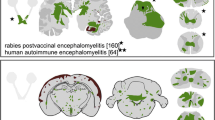Abstract
In this work we study wavefront propagation for a chemotaxis reaction-diffusion system describing the demyelination in Multiple Sclerosis. Through a weakly non linear analysis, we obtain the Ginzburg–Landau equation governing the evolution of the amplitude of the pattern. We validate the analytical findings through numerical simulations. We show the existence of traveling wavefronts connecting two different steady solutions of the equations. The proposed model reproduces the progression of the disease as a wave: for values of the chemotactic parameter below threshold, the wave leaves behind a homogeneous plaque of apoptotic oligodendrocytes. For values of the chemotactic coefficient above threshold, the model reproduces the formation of propagating concentric rings of demyelinated zones, typical of Baló’s sclerosis.






Similar content being viewed by others
References
Baló, J.: Encephalitis periaxialis concentrica. Archiv. Neurol. Psychiatr. 19(2), 242–264 (1928)
Barnett, M.H., Parratt, J.D.E., Pollard, J.D., Prineas, J.W.: MS: is it one disease? Int. MS J. 16(2), 57–65 (2009)
Barresi, R., Bilotta, E., Gargano, F., Lombardo, M.C., Pantano, P., Sammartino, M.: Demyelination patterns in a mathematical model of Multiple Sclerosis. Submitted (2016)
Bilotta, E., Pantano, P.: Emergent patterning phenomena in \(2\)D cellular automata. Artif. Life 11(3), 339–362 (2005)
Bozzini, B., Gambino, G., Lacitignola, D., Lupo, S., Sammartino, M., Sgura, I.: Weakly nonlinear analysis of Turing patterns in a morphochemical model for metal growth. Comp. Math. Appl. 70(8), 1948–1969 (2015)
Cerasa, A., Bilotta, E., Augimeri, A., Cherubini, A., Pantano, P., Zito, G., Lanza, P., Valentino, P., Gioia, M., Quattrone, A.: A cellular neural network methodology for the automated segmentation of multiple sclerosis lesions. J. Neurosci. Methods 203(1), 193–199 (2012)
Chalmers, A., Cohen, A., Bursill, C., Myerscough, M.: Bifurcation and dynamics in a mathematical model of early atherosclerosis: how acute inflammation drives lesion development. J. Math. Biol. 71(6–7), 1451–1480 (2015)
Dolak, Y., Schmeiser, C.: The Keller-Segel model with logistic sensitivity function and small diffusivity. SIAM J. Appl. Math. 66(1), 286–308 (2006)
Gambino, G., Lombardo, M., Sammartino, M.: Turing instability and traveling fronts for a nonlinear reaction-diffusion system with cross-diffusion. Math. Comp. Simul. 82(6), 1112–1132 (2012)
Gambino, G., Lombardo, M., Sammartino, M., Sciacca, V.: Turing pattern formation in the Brusselator system with nonlinear diffusion. Phys. Rev. Stat. Nonlinear Soft Matter Phys. 88(4), 042925 (2013)
Han, Y., Li, Z., Zhang, S., Ma, M.: Wavefront invasion for a volume-filling chemotaxis model with logistic growth. Comp. Math. Appl. (2016)
Hillen, T., Painter, K.: Global existence for a parabolic chemotaxis model with prevention of overcrowding. Adv. Appl. Math. 26(4), 280–301 (2001)
Hillen, T., Painter, K.J.: A user’s guide to PDE models for chemotaxis. J. Math. Biol. 58(1–2), 183–217 (2009)
Keller, E., Segel, L.: Model for chemotaxis. J. Theor. Biol. 30(2), 225–234 (1971)
Khonsari, R., Calvez, V.: The origins of concentric demyelination: Self-organization in the human brain. PLoS One 2(1), e150 (2007)
Lassmann, H.: Multiple sclerosis pathology: evolution of pathogenetic concepts. Brain Pathol. 15(3), 217–222 (2005)
Luca, M., Chavez-Ross, A., Edelstein-Keshet, L., Mogilner, A.: Chemotactic signaling, microglia, and Alzheimer’s disease senile plaques: is there a connection? Bull. Math. Biol. 65(4), 693–730 (2003)
Lucchinetti, C., Brück, W., Parisi, J., Scheithauer, B., Rodriguez, M., Lassmann, H.: Heterogeneity of multiple sclerosis lesions: implications for the pathogenesis of demyelination. Ann. Neurol. 47(6), 707–717 (2000)
Mulone, G., Rionero, S., Wang, W.: The effect of density-dependent dispersal on the stability of populations. Nonlinear Anal. Theory Methods Appl. 74(14), 4831–4846 (2011)
Mulone, G., Straughan, B.: Nonlinear stability for diffusion models in biology. SIAM J. Appl. Math. 69(6), 1739–1758 (2009)
Penner, K., Ermentrout, B., Swigon, D.: Pattern formation in a model of acute inflammation. SIAM J. Appl. Dyn. Syst. 11(2), 629–660 (2012)
Quinlan, R., Straughan, B.: Decay bounds in a model for aggregation of microglia: application to Alzheimer’s disease senile plaques. Proc. Royal Soc. A Math. Phys. Eng. Sci. 461(2061), 2887–2897 (2005)
Rionero, S.: Multicomponent diffusive-convective fluid motions in porous layers: ultimately boundedness, absence of subcritical instabilities, and global nonlinear stability for any number of salts. Phys Fluids 25(5), 054104 (2013)
Rionero, S.: Soret effects on the onset of convection in rotating porous layers via the “auxiliary system method”. Ricerche di Matematica 62(2), 183–208 (2013)
Rionero, S.: \({L}^2\)-energy decay of convective nonlinear pdes reactiondiffusion systems via auxiliary odes systems. Ricerche di Matematica 64(2), 251–287 (2015)
Rionero, S., Vitiello, M.: Stability and absorbing set of parabolic chemotaxis model of escherichia coli. Nonlinear Anal. Model. Control 18(2), 210–226 (2013)
Sherratt, J.: Wavefront propagation in a competition equation with a new motility term modelling contact inhibition between cell populations. Proc. Royal Soc. A Math. Phys. Eng. Sci. 456(2002), 2365–2386 (2000)
Wrzosek, D.: Global attractor for a chemotaxis model with prevention of overcrowding. Nonlinear Anal. Theory Methods Appl. 59(8), 1293–1310 (2004)
Acknowledgments
This work has been partially supported by National Group of Mathematical Physics (GNFM-INDAM) through a “Progetto Giovani” grant.
Author information
Authors and Affiliations
Corresponding author
Rights and permissions
About this article
Cite this article
Barresi, R., Bilotta, E., Gargano, F. et al. Wavefront invasion for a chemotaxis model of Multiple Sclerosis. Ricerche mat 65, 423–434 (2016). https://doi.org/10.1007/s11587-016-0265-0
Received:
Revised:
Published:
Issue Date:
DOI: https://doi.org/10.1007/s11587-016-0265-0




